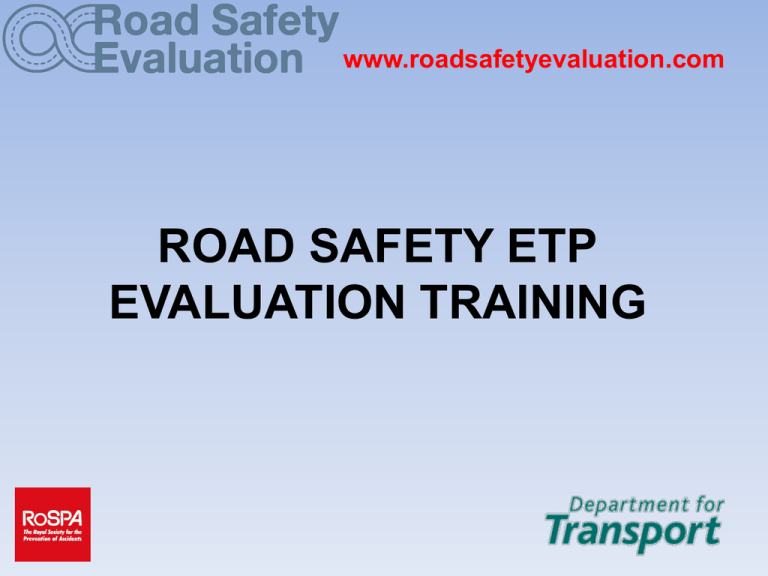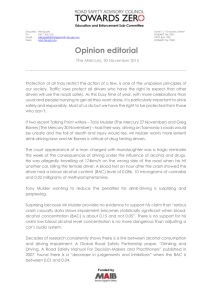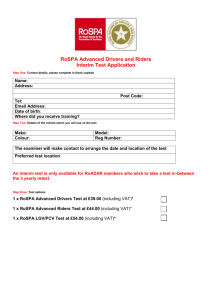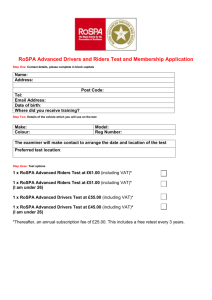ROAD SAFETY ETP EVALUATION TRAINING
advertisement

www.roadsafetyevaluation.com ROAD SAFETY ETP EVALUATION TRAINING www.roadsafetyevaluation.com AIM OF THE DAY To develop participants’ ability to carry out ETP evaluation www.roadsafetyevaluation.com Intended Learning Outcomes Be familiar with the meaning of specific terms used in evaluation Be able to distinguish between goals, aims and objectives Be able to set appropriate objectives Be able to construct and use a logic model Understand the pros and cons of different evaluation designs Be able to write closed and open questions www.roadsafetyevaluation.com Glossary Treasure Hunt! Remember that pre-seminar task? Check your answers with the definitions displayed around the room Make sure you introduce yourself to anyone you don’t already know! www.roadsafetyevaluation.com The Evaluation Process Planning and Evaluating an intervention – key steps What comes to mind? www.roadsafetyevaluation.com 7 Key Steps in Planning and Evaluating an Intervention 1) Needs Analysis – 1st data collection stage: What exactly is the problem and What is the best way to solve it? 2) Intervention Planning – What are we going to do and how? (aims and objectives) 3) Monitoring and Evaluation Framework – What, When and How to measure? 2nd data collection stage: base-line data www.roadsafetyevaluation.com 7 Key Steps in Planning and Evaluating an Intervention 4) Implement Intervention – 3rd data collection stage: collect monitoring data 5) Main data collection - Collect ‘post-intervention’ data. Review the data collected – have what you need? Analyse data 6) Report – Write report and disseminate findings 7) USE – Apply findings: amend intervention as necessary. Use in needs analysis stage (Step 1) of future interventions www.roadsafetyevaluation.com The Intervention-Evaluation Cycle Identify need, target group & likely ‘best’ intervention (local data, strategy, MAST, previous evaluations) Feed results and lessons learned into future projects Plan project and evaluation: Set aims & objectives, decide eval. design and methods Deliver intervention Publish and Share results Evaluate processes and/or outcomes www.roadsafetyevaluation.com What is the Difference... Between an Aim and an Objective? Between a Goal and an Aim? www.roadsafetyevaluation.com Definitions: a refresher Goal (Very broad): The overall reason behind the intervention – e.g. To reduce road casualties Aim(s) (Specific): What and who the intervention will change – e.g. To reduce the incidence of drink-driving amongst 17-25 year olds Objective(s) (Very specific): Specific outcome the intervention intends to achieve - e.g. To see an increase of 20% in the knowledge of 17-25 year olds about the legal penalties for drink-driving, by September 2011 To reduce mean scores in a self-report survey of drinkdriving behaviour completed by 17-25 year olds, by November 2011 (SMART) www.roadsafetyevaluation.com Example: ‘Older drivers project’ Aims: To increase self awareness of older drivers To improve driving skills of drivers over the age of 55 www.roadsafetyevaluation.com Older drivers project Objectives (By March 2012): To increase older drivers’ knowledge of the effects of medication on driving ability To improve older drivers’ journey planning To increase self identification of new aspects of their driving which could be improved To increase older drivers’ skills scores in a repeat test drive www.roadsafetyevaluation.com Logic model Components Inputs Outputs Outcomes Assumptions External factors Aims and objectives EXAMPLE LOGIC MODEL INPUTS OUTPUTS S.T.OUTCOMES INTERMED. LONG STAFF NUMBER OF EVENTS HELD INCREASE KNOWLEDGE ABOUT EFFECTS OF MEDICATION SKILLS PUT INTO PRACTICE INCREASE JOURNEY PLANNING SKILLS DRIVERS SELF IDENTIFY NEW AREAS FOR IMPROVEMENT OLDER DRIVERS CONTINUE TO REVIEW AND REFLECT ON THE AREAS FOR IMPROVEMENT MONEY ADIS RESEARCH NUMBER OF OLDER DRIVERS ATTENDING TEST DRIVES VENUE IMPROVED SKILLS OBSERVED FOOD/DRINK ASSUMPTIONS: Drivers accept the ADI assessments of their skills. Drivers identify themselves as an ‘older’ driver and see a need to attend the sessions/assessments. That the sessions and assessments will have a positive influence, i.e. Not make drivers unduly cautious or over-confident. EXTERNAL FACTORS: Adverse weather, local news stories involving older drivers, increased insurance premiums, family members, poor health. www.roadsafetyevaluation.com www.roadsafetyevaluation.com Evaluation Designs Post only with no comparison group Post only with comparison group Post then pre, no comparison group Pre and post with no comparison group (non experiment) Pre and post with comparison group (quasi experiment) Randomised controlled trial (RCT) www.roadsafetyevaluation.com Evaluation Designs Points to consider: How many groups of participants need to be surveyed and how many times? (e.g. A post only design with no comparison group only surveys one group once) What are the implications for your time and resources, participants’ responses, and drop-out rates? Any base-line measurement taken? You need a baseline to be able to measure change www.roadsafetyevaluation.com Evaluation Designs More points to consider: Can you know if it was the intervention that caused the change, or factors external to the intervention? e.g. age/maturation, other interventions in the area, or random chance (such as someone close to the participant being involved in a road traffic incident). www.roadsafetyevaluation.com Methods in our madness!! You want to show effectiveness and have the opportunity to do a quasi experiment (e.g. Preand post with comparison group) Choose a method suitable for the intervention you have been working on, e.g. Telephone interview or self-complete questionnaire Write 5 questions. At least one question should be open ended. www.roadsafetyevaluation.com Question Writing Basics Keep questions short Do not ask two questions in one, e.g. ‘How enjoyable and informative did you find this workshop?’ Be sure that everyone will understand the question in the same way – pre-test questions Avoid jargon and abbreviations – do not assume people will know what something means just because you do, e.g. ‘serious injury’, or ‘ADI’ www.roadsafetyevaluation.com Question Writing Basics Avoid leading questions, e.g. ‘Do you agree this workshop was enjoyable?’ as opposed to: ‘Please rate how enjoyable you found this workshop’ Avoid using two negatives in one question, e.g. ‘How much do you agree with the following statement: I never not wear a seat belt’ Avoid surplus questions. Do you really need to ask that question? How is it different to your other questions? How will you use the data? www.roadsafetyevaluation.com Question Writing Basics Be Specific about what you are asking: ‘Please rate this course on a scale of 1-5 with 1 meaning Poor and 5 meaning Excellent’ ‘Please rate the following aspects of this course on a scale of 1-5 with 1 meaning Poor and 5 meaning Excellent’ (Opportunity to ask questions, Knowledge of presenters, Use of Examples...) www.roadsafetyevaluation.com Training Day Survey Take a look at our own training day evaluation survey. What are the advantages and disadvantages of this design and method? Please complete the survey before you leave if possible. www.roadsafetyevaluation.com We’re here to help lsimkins@rospa.com jmcwhirter@rospa.com Thank you!








